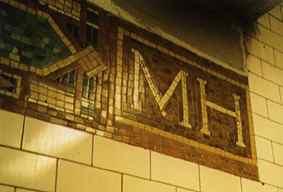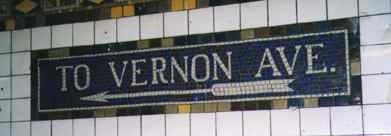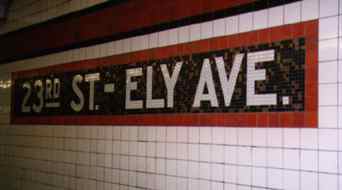Signs on subway platforms sometimes have a way of preserving for posterity the former names of streets under which they ran, or former names of station stops. This is especially true in Queens, along the 7 line: 33rd (Rawson St), 40th St (Lowery St), 46th St (Bliss St), 52nd St (Lincoln Ave) and 69th St (Fisk Ave); the N line: 39th Ave (Beebe Ave), 36th Ave (Washington Ave) and 30th Ave (Grand Avenue); and the A line: 80th St (Hudson St); 88th St (Boyd Avenue), 104th St (Oxford Ave), Beach 44 St (Frank Ave), Beach 60 St (Straiton Ave), Beach 67 St (Gaston Ave).
The above stops have had their old station names retained through various eras of signage, and the old names are today preserved with modern black and white metallic signs. Other areas in the subways, though, have old names that the subway system seems to have overlooked. For example…
What is that mysterious “L” in the mezzanine of the Hoyt-Schermerhorn IND station (A,C,G)?
The L stands for “Loesser’s”. The store stood above the station decades ago. [as of 2010, these signs had been removed]




Slattery Plaza was a small cluster of stores that occupied a traffic island on Horace Harding Boulevard in the 1930’s and 40’s, and disappeared when the Long Island Expressway was built, said Jeff Gottlieb, president of the Central Queens Historical Society.
He said the plaza was named for James Slattery of Jackson Heights, an engineer who helped map the BMT subway lines. NYTimes

The village of Newtown consolidated with the City of New York in 1898. It is remembered in Newtown High School, Newtown Avenue and Road, and this IND subway station. Unusually, Newtown had been absorbed by NYC long before its construction had begun!
Mott Avenue was replaced by an extension of the Grand Concourse in the 1920s.
Mott Avenue was named for Jordan L. Mott, an early landowner in that part of the Bronx in the early 1800s. The village of Mott Haven was incorporated in 1848 and annexed to New York City in 1874. Mott invented the base-burner stove (which could use anthracite) in 1833 and founded the Mott Iron Works on the Harlem River. The name Mott Haven for the neighborhood has persisted through the years.
It’s unclear why the name was included, though: by the time the station was built in the 1930s, the street had already had its name changed to 65th Street.
6/7/98

